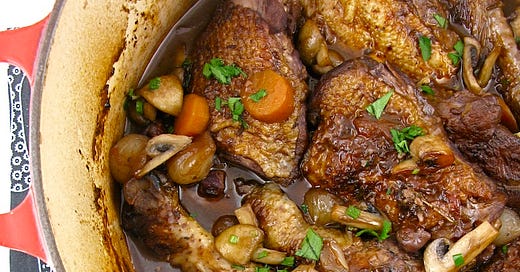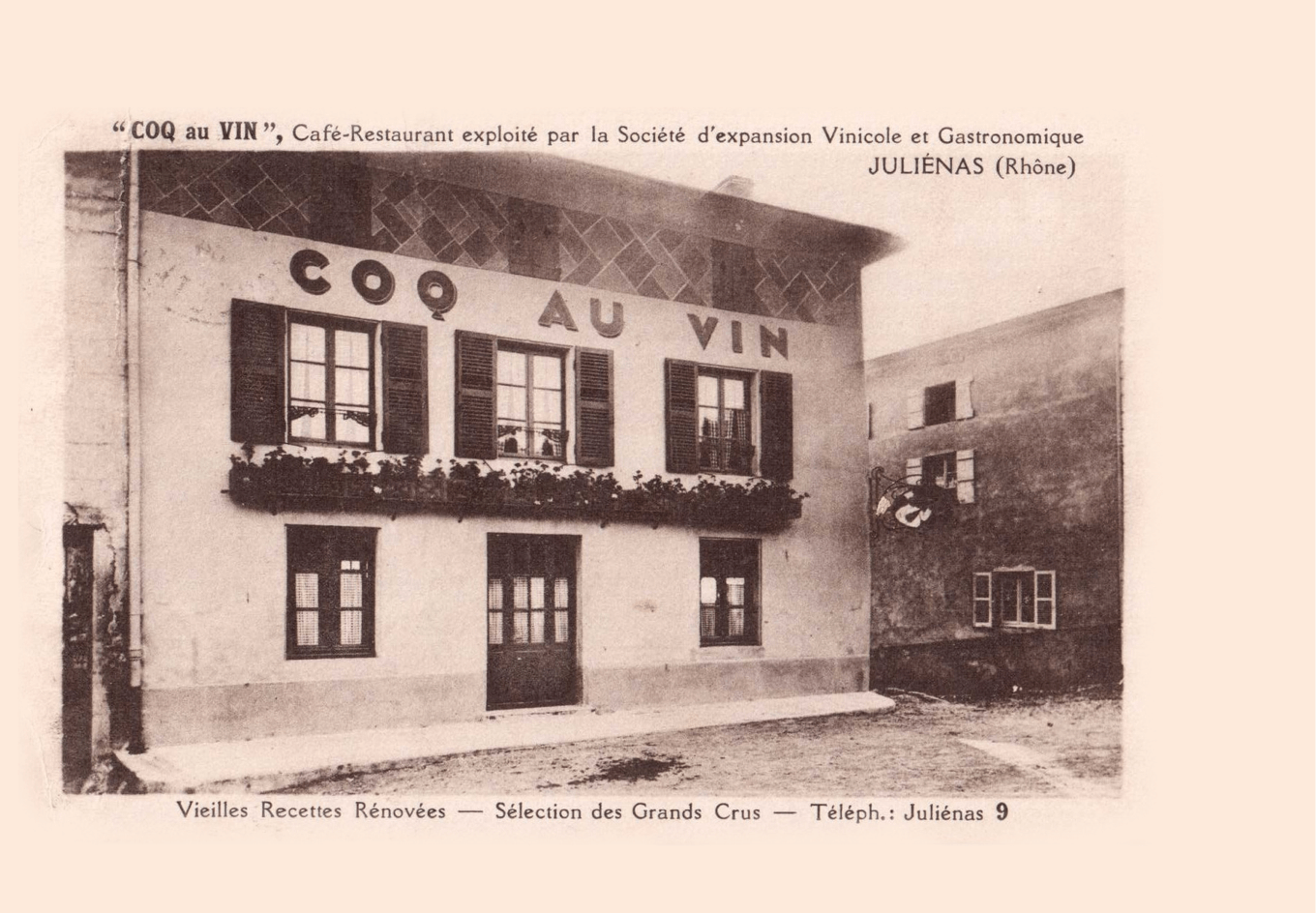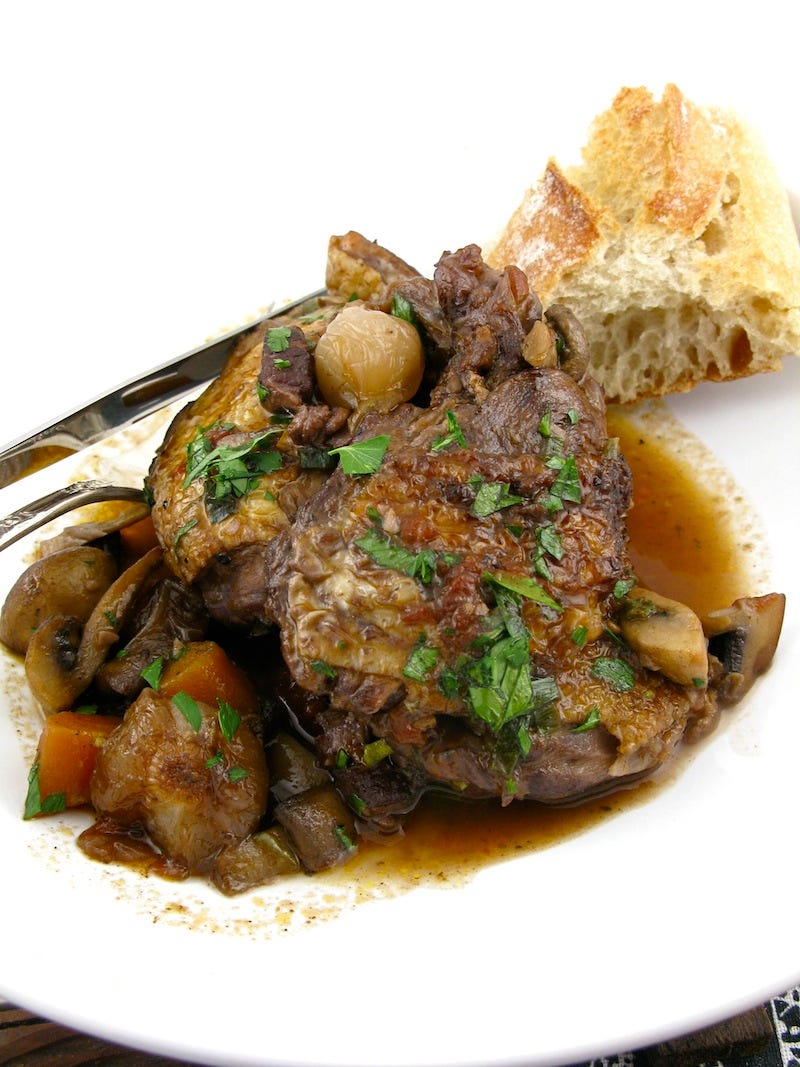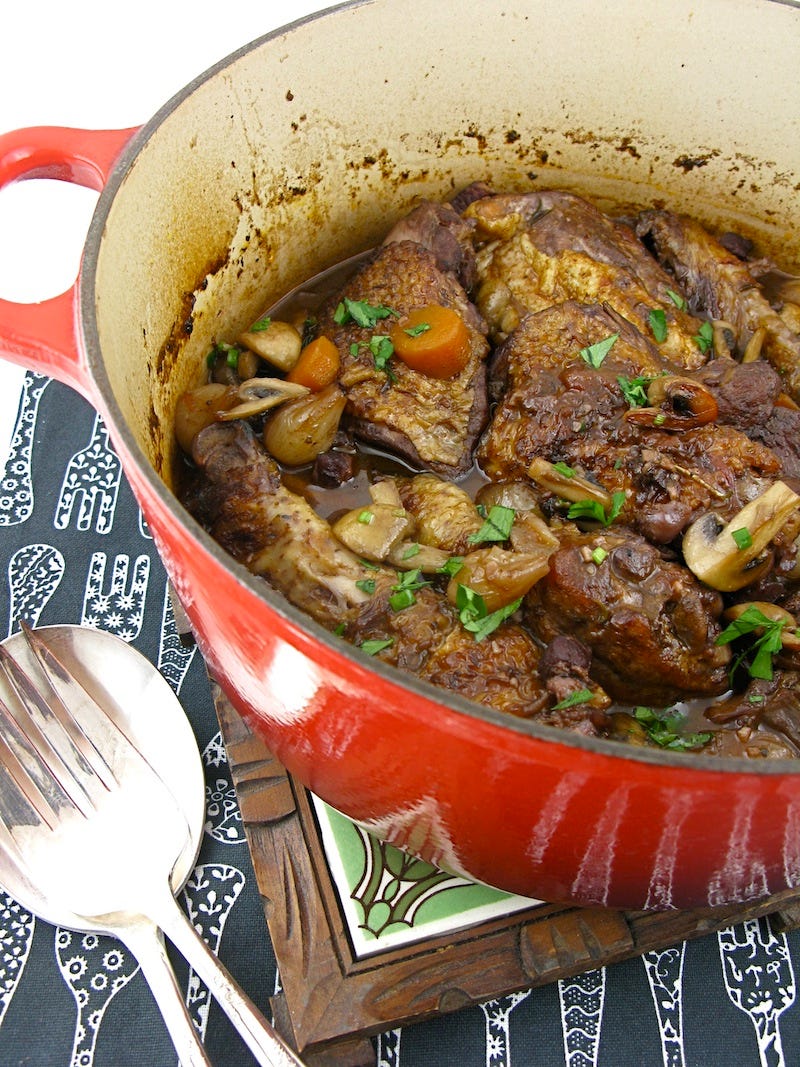The fate of a nation depends on the way that they eat. - Brillat-Savarin
Curious beginnings for one of France’s most emblematic dishes, coq au vin, or so legend has it. The very first coq au vin is said to have been cooked in 52 BCE during the Gallic Wars. Julius Caesar, Roman general, and Vercingétorix, King of the Gauls, were preparing to face one another in the Battle of Gergovia, and each had been attempting to impress fear and awe in the other. Vercingétorix decided to send a cock, a rooster, symbol of the fury, courage, and combativeness of the French forces, to the Roman leader. The day before the battle, Caesar, as one gentleman to another, invited Vercingétorix to dine, then served him the symbolic fowl simmered in the local wine, a luxurious dish for the time, yet obviously meant as a great tease.
Vercingétorix went on to win the Battle of Gergovia, defeating Caesar and uniting Gaul's disparate clans, at least temporarily, but the symbolism, at the end of the day, was on his side.
Other than this one episode, and as intimately tied to French history as it was, all written trace of coq au vin apparently disappeared until the 18th and 19th centuries; although a stew that was strictly rustic, peasant fare might not have been documented at all. In my own collection of old French cookbooks, it is rather hard to find any recipe for this dish at all until the 1920s, and even then it’s rather spotty. The dish itself does suddenly pop up in the early 20th century in the wine region of Beaujolais when the owners of a small café-restaurant Le Coq au Vin in the town of Juliénas, a gathering place for local winemakers to enjoy pints of Beaujolais and dishes of coq au vin, claimed to have created the dish. This fragrant stew had also become popular in the regions of Bourgogne, Alsace, Champagne, and the Auvergne, each region claiming title to the birthplace of coq au vin, using, of course, the production of their own terroir.
This ancient dish has evolved over the years into a standard of French cuisine; while we Americans might think of this dish as luxurious and sophistocated, a dish reserved for a special meal, this is classic comfort food in a French home. Rooster, of course, is no longer used, chicken having long taken the place of the rarer - and much tougher - farmbird. Chicken is braised in wine with lard or lardons, pork bacon, white mushrooms, and small or pearl onions. Each of these ingredients as well as the long, slow cooking, seem to indicate a homey, common dish.
The marriage of food and wine, in the kitchen as well as on the table, goes back to Antiquity. We might suspect that during the Middle Ages, wine of lower quality might very well have been used for cooking, its sharp, vinegary flavor covered with copious amounts of spices or balanced with honey, but even small, inexpensive and local wines are good and have always been used in the pot as well as served with the meal, the heightened flavor and slight acidity of the fermented liquid adding a complementary characteristic to the dish, flavoring both meat and sauce. It’s not a surprise, either, that both onions and mushrooms found their way into ancient versions of coq au vin: onions have been cultivated and used in cooking for at least the last 5,000 years, and mushrooms consumed for about 12,000. And both were commonly accessible and cheap. Nothing about this dish has ever really merited being thought of as luxurious or noble. Coq au vin is a dish in the same family as bœuf bourguignon and daube, meat cooked slowly in wine until tender, and like many recipes in this tradition, there were many ways to prepare it, variations appearing in the same cookbooks, some using more ingredients and requiring a more complicated cooking process, and some simple and straightforward, but the basics - chicken, onions, mushrooms, herbs, and, of course, plenty of wine- were always the same.
Don’t be daunted by your impression of coq au vin as a complicated or expensive dish. The ingredients are easily available and most are what I consider kitchen cupboard staples, and while the mushrooms and onions are prepared separately, they are done while the chicken simmers; the recipe is rather straightforward if everything is well-prepped beforehand and it is very much worth the effort.
Classic coq au vin
You can make the coq au vin ahead of time and, once cooked, remove from the heat, cover, and allow to sit; the flavors meld and improve. When ready to serve, place over a low or medium-low flame and allow to heat through while you prepare rice, pasta, or another side dishes.
2 ½ to 3 pounds (about 1.5 kg) chicken pieces, or enough for 4 people
2 tablespoons olive or good cooking oil
4 ounces (120 grams) smoky lardons or smoked slab bacon, about ½-inch (1 cm) thick, cut into ½-inch (1 cm) slices
¼ - ⅓ cup (65 to 85 ml) brandy or cognac, optional but recommended
2 carrots, cleaned, trimmed, sliced into ½-inch- (1 cm) thick chunks
2 cloves garlic, pressed or finely minced
1 bay leaf
¼ teaspoon thyme, fresh or dried
⅓ cup (65 ml) canned Italian plum or cherry tomatoes
2 ½ - 3 cups young fruity red wine - a gamay, Beaujolais, Chinon, Zinfandel, Mâcon, Chianti, or similar
Salt and freshly ground black pepper
1 – 2 cups (250 – 500 ml) chicken stock
Chopped fresh flat leaf parsley to serve
16 – 20 small pearl onions – about 1 cup or so – no more than 1-inch (2 cm) width, or more as desired
1 tablespoon each butter and olive oil
Pinch sugar
½ cup red wine
Small amount chicken stock or water and a pinch of cube to braise
1 to 2 bay leaves
1 – 2 bay leaves
Pinch fresh or dried thyme
10 ounces to 1 pound (300 to 500 grams) fresh white mushrooms
1 to 2 tablespoons butter or olive oil for sautéing, more or less as desired
1 tablespoons chopped chives or the greens from the pearl onions
Clean and trim the chicken pieces, removing excess skin and fat pockets; rinse and pat dry.
In a large heavy pot or Dutch oven, heat a tablespoon of olive oil then add the lardons or bacon cubes; fry, tossing often, until crispy.
Remove the lardons with a slotted spoon to a plate, leaving the fat/bacon grease in the pot.
Add an additional tablespoon of olive oil to the fat in the pot if necessary and add the chicken pieces in one layer; do not crowd. Brown the chicken on all sides. If need be, brown the chicken in batches.
Once all of the chicken is well browned, return all of the pieces to the pot and add the brandy; allow the brandy to boil until almost evaporated, only about a minute or two.
Return the cooked lardons to the pot with the chicken; add the carrots, garlic, bay leaf, thyme, the tomatoes, the wine (I add 2 ½ cups wine; if I add all 3 cups wine in my pot the chicken will be immersed in the wine and would leave no room for chicken stock) and season lightly with salt and pepper.
Add enough of the chicken stock to just barely cover the ingredients.
Bring just to the boil, reduce heat to a simmer, cover partially, and allow to simmer until the chicken is cooked through and very tender, about 45 minutes to an hour.
Meanwhile, prepare the braised onions and sautéed mushrooms:
Clean and trim the white pearl onions. Sauté in 1 tablespoon of browned butter + 1 tablespoon olive oil + a pinch of sugar until golden. Add ½ cup red wine (the same wine used for the coq au vin) and cook for several minutes until the wine evaporates and leaves a glaze in the bottom of the pan.
Add enough chicken stock to braise the onions – not more than half a cup, just enough to come up about ¼ inch, with the bay and thyme; allow onions to simmer until tender. Season to taste, if needed. Remove from heat and set aside.
Clean, trim, and quarter the mushrooms and sauté in 1 to 2 tablespoons butter until tender and browned. Season with salt and pepper and toss in the chopped chives or onion greens. Remove from heat and set aside.
When the chicken is very tender and cooked through, if the sauce is too watery simply lift the chicken and vegetables out of the pot and transfer to a bowl or plate and continue to simmer the sauce until it reduces to desired consistency. Skim off the fat from the surface of the sauce, taste and correct seasoning.
Return the chicken and vegetables to the sauce in the pot, add the braised onions and sautéed mushrooms, and reheat gently, simmering for a few minutes to heat through and so the flavors meld.
Serve simply over rice or with a vegetable. Garnish with chopped fresh parsley and enjoy with a glass or two of red wine.
Thank you for subscribing to my Substack, Jamie Schler’s Newsletter, where I share my (mostly French) recipes, my hotel and my jams, my projects, and the stories of my life. You can support my work by sharing the link to my Substack with your friends, family, and your social media followers. I’m so glad that you’re here.







My very first coq au vin was consumed in the Loire Valley not terribly far from where you are now. I was 16 and staying in an old 15th Century farmhouse on the 4th of July where the teenage sons of the owner were pushing two sheltered Beverly Hills girls on rope swings and sweet talking them. The girls thought the boys were saying they wanted to kiss them. I was sitting on a bench nearby and my understanding was that the boys wanted to fuck them. Then we were all called into dinner where we had steaming bowls of coq au vin placed in front of us, each with a tiny American flag firmly planted in the tender, fragrant hen flesh. It was sweet and weird and wonderful and the experience was completely lost on nearly everyone except maybe me. Now I have a strong desire to make this recipe half hoping some hot French farm boy is waiting somewhere with a swing.
Coq au vin is one of my favourites!
When I was in Beaujolais a few years ago, we had lunch at a very unassuming place, just a country restaurant on the side of the road in the middle of nowhere, that was absolutely jammed with everyone from construction workers to grandmas to bankers. And of course, everyone was having the coq au vin. 🐓🍷